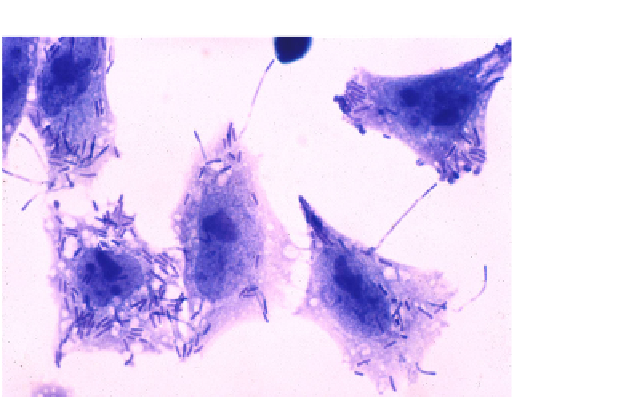Biology Reference
In-Depth Information
FIGURE 7.2
Tissue culture model of
Shigella
invasion, intracellular motility, and multiplication.
A semi-confluent monolayer of mouse L2 fibroblasts was infected with
S. flexneri
2a for 30 min-
utes. The monolayer was washed and tissue culture medium with gentamicin was added to kill
extracellular bacteria. The monolayer was fixed and stained 2 hours later. Bacteria can be seen as
darkly staining rods within the cytoplasm of the eukaryotic cells. Intracellular movement of the
bacteria and contact with the plasma membrane causes the formation of 'fireworks,' cytoplasmic
protrusions that contain bacteria at the ends.
Similarly, the invasive phenotype of EIEC is also temperature regulated (
Small
and Falkow, 1988
). Temperature regulation of virulence gene expression is a
characteristic of other human pathogens such as pathogenic
E. coli, Salmonella
typhimurium, Bordetella pertussis, Yersinia
spp., and
Listeria monocytogenes
.
Regulation of gene expression in response to environmental temperature is a
useful strategy for bacteria. This strategy permits
Shigella
and EIEC to trigger
gene expression by sensing the ambient temperature of the mammalian host
(i.e. 37°C) thereby economizing energy that would otherwise be expended on
the synthesis of virulence products when the bacteria are outside the host. The
system also permits the bacteria to coordinately regulate expression of multiple
unlinked genes that are required for the full virulence phenotype.
Cell biology
Shigellosis, or bacillary dysentery, is an acute inflammatory disease of the colonic
mucosa that results from invasion and cell-to-cell spread of the bacteria. Infec-
tion occurs via the oral route by ingestion of the bacteria in contaminated food
or water.
Shigella
and EIEC display a remarkable ability to survive the acidity of
the stomach (
Gorden and Small, 1993
;
Jennison and Verma, 2007
). After passing
through the stomach, the bacteria transit through the small intestine to reach the
colon where infection is established. Studies in several different animal models
demonstrate that
Shigella
gain access to the colonic subepithelium and establish

Search WWH ::

Custom Search